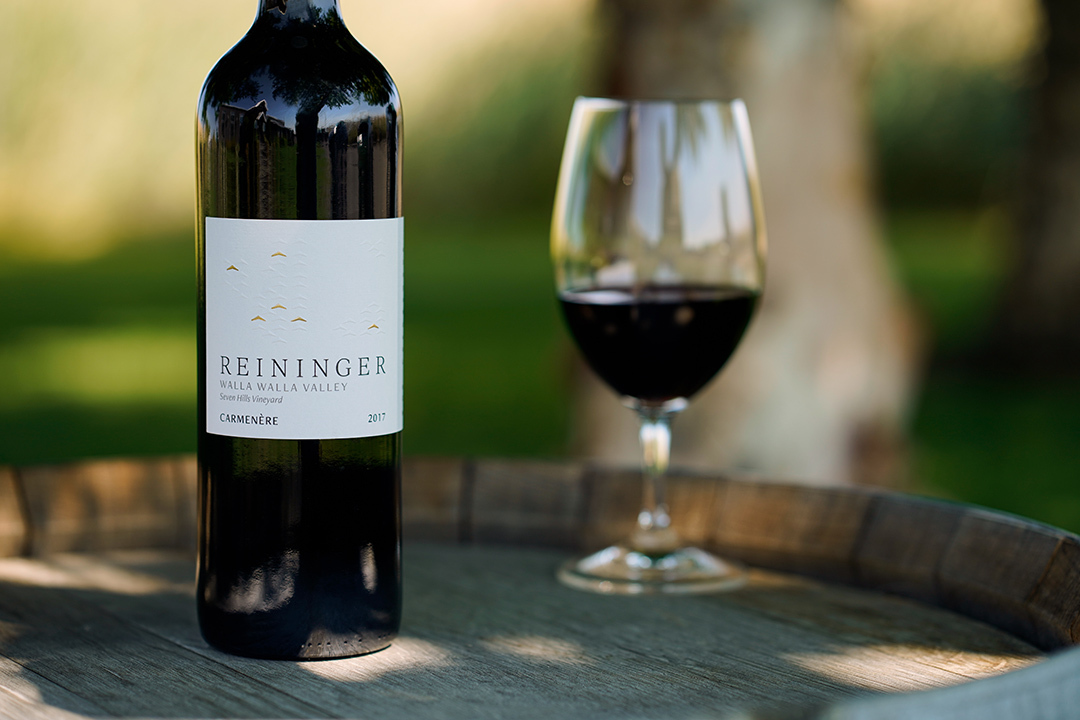May 18 2020
The Lost Bordeaux: An Exploration into Carmenère
Green peppercorn. Jalapeno. Smoke. Sour Cherry. Raspberry. These are all words to describe an ancient varietal that REININGER has specialized in since 2002. Carmenere, otherwise known as the Lost Bordeaux, has a long and illustrious history. Between the various synonyms the grape has shared with other varieties to the common characteristics with other fruit, Carmenère has become the mistaken doppelganger for many of the Bordeaux varieties. It’s no wonder that it hasn’t come into its own and embraced its individuality in single varietal bottlings until modern day. Now it’s celebrated all over the world on November 24 on International Carmenère Day, and at REININGER we celebrate it in the Spring with the wine club release of our Walla Walla Valley Carmenère, sourced from Seven Hills Vineyard.
Carmenère, pronounced car-men-nair, derives its current name from the Latin root “carmin”, or crimson, due to the crimson color the leaves take on in autumn. Carmenère has thought to have originally been called Biturica, which is also the original name for Bordeaux, because Tuscany used it in blends under the name “Predicato di Biturica.” It’s also been referred to as Grande Vidure, which Cabernet Sauvignon shares the same synonym. The name Grand Vidure led many to suspect Carmenère was a clone of Cabernet Sauvignon, but genetics have found it is a cross between Cabernet Franc and Gros Cabernet.
Regardless of its many names, Carmenère once thrived in Bordeaux, France, particularly the Medoc region. One of six Noble Bordeaux red varietals, Carmenère was an important blending component in wines produced in Graves and Pessac Leognan. During the 1860s, Carmenère, along with much of France’s vines, were infested by phylloxera, a tiny little aphid that came over from America. Already a difficult grape to grow, the Carmenère vines were pulled up after the phylloxera epidemic and replaced with grapes that were higher yields for exportation: Cabernet Sauvignon and Merlot.
During this same time period (1850-1860s), French vine cuttings of what was believed to be Merlot were sent to Chile. The Chilean growers referred to the grapes as Merlot Peumal, after the Peumal Valley in Chile where the vines were originally planted.The grapes thrived in Chilean soil, but didn’t necessarily taste like your everyday Merlot. The grape is prone to methoxypyrazine, or pyrazine for short. It’s an organic compound that creates a strong peppery note in wines. It wasn’t until the 1994 when scientists tested these “Merlot” vines that they discovered it was the long-lost Carmenère grape. Today, Carmenère is the grape of Chile, just like Cabernet Sauvignon is the grape of Napa, or Malbec is for Argentina.
But Chile was not the only country to mistake this esoteric grape for something else. Plantings of what was thought to be Cabernet Franc made its way to Italy, Australia and New Zealand (in 1990, 2002 and 2006 respectively), but was later determined to be the illustrious Carmenère.
In 1997, Carmenère was planted purposefully in Walla Walla by Leonetti’s Chris Figgins at the Leonetti Mill Creek Upland Vineyard. The following year some of those cuttings were shared with Seven Hills Vineyard and Mark Colvin of Colvin Cellars (now out of business). REININGER purchased a block of Carmenère grapes from Seven Hills Vineyard as soon as they were eligible and our first vintage was released in 2002. To date, we are the longest running producers of Carmenère in Washington. Renowned wine writer, Paul Gregutt, hailed the 2006 Reininger Carmenère as making “a strong claim for being the best Carmenère in Washington, if not the country.”

Aged in French oak, our 2017 vintage has a beautiful dark crimson color and exhibits spicy aromas of white pepper, currant, eucalyptus and damp soil. Flavors of under ripe raspberries, currant, white pepper and a hint of black cherry mirror the nose. This vintage has achieved perfect balance between its acidity and medium-fine tannins; a silky, smooth mouthfeel and a finish that just won’t quit. The rustic countenance of this ancient varietal pairs beautifully with any grilled or smoked foods.
"Wow! I am stunned by this wine... Rich and full-bodied on the palate, the wine drinks more like a Cabernet than a Carmenère and boasts a balanced structure with precision. I think many Chilean producers could learn something from Reininger's Carmenère, as it stands as a testament to the grape's capabilities. This has a creamy and lush mouthfeel and ends with a thought-provokingly long finish. I'm impressed. Bravo! This may be one of the best North American Carmenère expressions made.” - Wine Advocate, 91+ points
Year after year, our Carmenère sells out almost exclusively to our members, and this year was no different. We have only 30 cases that we just released to the public of this 91+ point Wine Advocate rated red. It’s only around for a few months so stop in and experience this Lost Bordeaux and see if maybe it can find its home in your cellar.